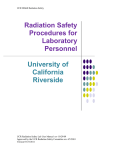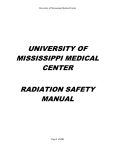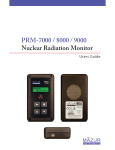Download Radiation Safety Training and Procedure Manual for Safe Use of
Transcript
Radiation Safety Training and Procedure Manual for 2012 Safe Use of Analytical X-ray Equipment Purpose Analytical X-ray equipment is used for x-ray diffraction analysis, fluorescence or direct x-ray transmission analysis of materials. These analytical x-ray systems are comprised of components that utilize X-rays to determine elemental composition, or to examine the microstructure of materials. These analytical x-ray devices are used for non-medical purposes. The primary objective of this program is to keep occupational exposures to radiation as low as reasonably achievable (ALARA) while utilizing these types of equipment. This safety program establishes UVa procedures for the safe operation of analytical X-ray equipment and the associated potential radiation hazards. Regulatory Authority The Ohio Department of Health, Bureau of Radiation Protection is responsible for the following program areas: • • • Registration and inspection of radiation-generating equipment. Licensing radiation-generating equipment operators and nuclear medical technologists. Certification of radiation experts. X-ray machines and other ionizing radiation producing devices, such as electron microscopes, present a potential safety hazard to students, staff, and faculty if the device is not used and/or stored properly. The Ohio Department of Health ( ODH) will inspect the university’s x-ray machines and operations on a periodic basis. For research and analytical devices this period is every 3 years. The ODH has the authority to issue violations for any regulation that an x-ray user, researcher, or Principal Investigator (PI) is not following current Ohio Law. This manual is intended to inform non-human/non-medical use x-ray device users of the regulations with which they are required comply. Also included are the ODH regulations for the safe operation of x-ray machines and other Radiation Producing Device (RPD) and specific practices to aid radiation equipment users in minimizing their exposure to ionizing radiation. If there are any questions concerning the applicability of any regulation, please contact the Radiation Safety Officer In Environmental Health and Safety 216-687-9306. Potential hazards of Radiation Generating Devices Analytical x-ray devices, such as diffract-o-meters, use very high intensity, collimated x-ray beams to examine the properties of materials. The x-ray dose rate at the beam port can be several thousand rad per second. Exposure of extremities to the primary x-ray beam can result in severe radiation burns in a matter of seconds. Radiation burns are the principle hazard associated with the use of analytical x-ray equipment. The leakage or scatter of the primary beam through apertures in ill-fitting or defective equipment can produce very high intensity beams of possibly small and irregular cross section. Radiation Safety Training and Procedure Manual for 2012 Safe Use of Analytical X-ray Equipment Dose rates near the machine from scattered radiation can be as high as a few hundred millirems (mrem) per hour. Although not likely to cause burns, doses from scattered radiation can exceed regulatory limits if the beam is not properly enclosed or contained. In fluorescence, the primary beam strikes the sample inside a shielded enclosure, and only scattered radiation and secondary beam radiation excited in the sample as a result of irradiation emerges from the machine for analysis. Consequently, external levels are much lower in the fluorescence mode than in the x-ray diffraction mode. Modern x-ray diffraction machines incorporate shielding and safety design features to prevent both acute local accidental exposure and chronic exposure to radiation. Operators should be especially cognizant of protective devices incorporated into their machines and the possibility for failure or malfunction. In addition, decreasing time, increasing distance, and shielding represent the most practical methods a radiation worker can use to minimize radiation exposure. X-ray radiography is of even greater potential hazard due to the higher applied voltages and the longer exposure times. Typical applied voltages of 200 keV or greater are common. The distances between the primary beam and the target are generally an open area up to a couple of feet. Exposure times can be of several minutes or even hours in gauging devices. Responsibilities The University Radiation Safety Officer has the responsibility to audit and survey all registered radiation generating equipment at Cleveland State University. RSO is also responsible for maintaining an accurate registration of all units with ODH. Principle Investigators (PI) bear the primary authority, responsibility, and accountability for ensuring regulatory compliance and radiological safety within their work groups as set forth in this manual and with the Ohio Department of Health regulations. The PI is responsible for notifying RSO of the acquisition, relocation, transfer, or disposal of any x-ray generating machine. Individual users are also responsible for compliance with this manual and the ODH regulations. Individuals responsible for proposal development are responsible for allocating sufficient resources during proposal development to allow adequate implementation of the requirements of the Radiation Safety Program. Planning The importance of planning the installation and use of machines cannot be overemphasized. Adequate lead times must be allowed for review of facilities that require new construction or remodeling and registration with ODH. Pre-operational evaluation of shielding and operating procedures shall be also required before routine use of such machines can be authorized. Radiation Safety Training and Procedure Manual for 2012 Safe Use of Analytical X-ray Equipment Inspections, Surveys and Inventory The ODH will inspect all x-ray devices on a periodic basis (every 3 years). ODH has the authority to issue violations of the regulations. If the x-ray PI does not correct these violations within 30 days, the ODH has the authority to issue a “Cease Operations Order”. Financial penalties may also be assessed the PI. The Radiation Safety Officer shall perform inspections, surveys, and inventories with the appropriate frequencies as indicated in the appropriate section of the ODH regulations. RSO will also perform an annual inventory of all inoperable units. Radiation Basics X-rays are known as ionizing radiation because x-rays posses sufficient energy to remove electrons from the atoms with which the x-rays interact with. There are three quantities primarily used for describing the intensity of an x-ray beam: • • • Exposure Absorbed Dose Dose Equivalent Exposure Is a measure of the ionization produced in air by x-ray or gamma radiation. It is the sum of the electrical charges of all of the ions of one sign produced in air when all electrons liberated by photons in a volume of air are completely stopped in the air, divided by the mass of air in the volume element. The unit of exposure is the roentgen ( R). 1 roentgen = 2.58 *10^-4 Coulombs of charge produced per Kg of air. Absorbed Dose Is the amount of energy imparted to matter by ionizing radiation per unit mass of irradiated material. The unit of absorbed dose is the rad. 1 rad = 100 ergs of energy deposited in one gram of material. Limitations: Absorbed dose does not indicate the effectiveness of various types of radiation in causing biological harm. Different types of radiation may deposit the same amount of absorbed dose but produce different effects and different levels of damage. For instance, charged massive alpha particles will interact more intensely and deposit energy over a shorter distance within a cell than uncharged mass less gamma rays. Consequently, some radiations are more effective than other radiations at producing biological damage, even though equivalent amounts of energy are deposited overall. The quantity, dose equivalent, described in the next paragraph takes into account the abilities of differing radiations to cause damage Radiation Safety Training and Procedure Manual for 2012 Safe Use of Analytical X-ray Equipment Dose Equivalent Is the product of absorbed dose, the quality factor, and any other modifying factors necessary to express, on a common scale for all ionizing radiation, the dose incurred by exposed persons. The unit of dose equivalent is the rem. X-ray Production X-rays are produced when charged particles, are accelerated by an electrical voltage. Whenever a high voltage, vacuum, and a source of electrons are present in any device, x-ray can be produced. Most x-rays devices emit electrons from a cathode, accelerate them with a voltage within a vacuum, and then impact an anode, which emits x-ray photons. Figure 1, Coolidge x-ray tube, Oak Ridge Associated Univ. While x-rays are extremely useful in areas ranging from basic research to trace element analysis to radiography, the actual production of x-rays is rather inefficient. More than 99% of the kinetic energy of the electrons impacting a particular target material results only in the production of heat. Heat buildup in the x-ray production target is a key limiting factor in the design of x-ray producing devices. Bremsstrahlung The electron as it strikes the anode, can be stopped by a single dramatic collision or by a series of collisions. During each collision the electron loses kinetic energy, which is balanced by the creation of a photon. The photons produced during these collisions are called Bremsstrahlung radiation. And is a consequence of the electrons deceleration. Most photons are in the x-ray portion of the electromagnetic spectrum. Bremsstrhlung production in a given target material varies directly as the square of the target material’s atomic number (Z) and inversely as its atomic weight (A). Bremsstrahlung is most effectively produced when small charged particles, bombard atoms of a high (Z) number such as tungsten. Bremsstrahlung can in theory be produced with low atomic weight materials. Radiation Safety Training and Procedure Manual for 2012 Safe Use of Analytical X-ray Equipment Photon Energy and Total Power For radiation protection purposes, it is important to distinguish between the energy of individual photons in an x-ray beam and total energy of all photons in the beam. It is important to distinguish between average power and peak power in a pulsed x-ray device. Normally, the individual photon energy is given in electron volts (eV), whereas the total power of a beam is given in watts (W). The photon energy may be varied either by changing the voltage or by using filters that are analogous to the colored filters used in photography. Changing the current may vary the number of photons emitted. Voltage The photon energy produced by an x0ray device on the voltage , which is measured in volts (V). A voltage of 10 kV will produce up to 10 KeV x-ray photons. Most of the x-ray photons produced by a given maximum electron acceleration potential will be approximately one third of the maximum electron acceleration potential. Current The total number of photons produced by an x-ray device depends on the current, which is measured in amperes, or amps (A). The higher the electron current, the more x-ray photons are emitted from the anode. The x-ray current from many international x-ray devices are measured on the order of milliamps (mA). Determining Total Power Total power equals voltage multiplied by current (W=V x A). an example of this would be a 1kV device with a current of 1 mA would produce 1 Watt of power. Biological Effects X-rays can penetrate deeply into the human body, strip electrons from orbit, and break or modify chemical bonds within critical molecules that make of the cells of the human body. This process can cause cell injury and even cell death, depending on the dose , dose rate of exposure. In some cases , altered cells are able to repair themselves . In other cases, the effects are passed to daughter cells through cell division and after several divisions can result in a group of cells with altered characteristics. The division of these cells may be the first step in tumor or cancer development. Several factors contribute to the biological effects of x-ray exposure. • • • • • • Dose rate Total Dose received Energy of the radiation Area of the body exposed Individual Sensitivity Cell Sensitivity Radiation Safety Training and Procedure Manual for 2012 Safe Use of Analytical X-ray Equipment Dose rate Depending on the period of time over which it is received, a dose is commonly categorized as acute or chronic. An acute dose is received in a short period of time (seconds to days); chronic doses are received over a long period of time (weeks to years). For the same total dose, an acute dose is more damaging than a chronic dose because the cell does not have adequate time to repair all damage between exposures, thus resulting in residual enduring cell damage. Total Dose Received The higher the total amount of radiation received, the greater the effects observed. The effects of an acute dose of more than 100 rem are easily observed. However, the signs and symptoms of an acute dose of amounts less than 10 to 25 rem are not easily observed. Currently effects below 10 rem exposure cannot be reliably quantified. The effects of a chronic dose are also difficult to observe. Although chronic effects have not been observed directly, it is assumed under the ALARA philosophy that the higher the total dose, the greater the risk of contracting cancer or other long-term effects. Energy of the Radiation The energy of x-rays can range from less than 1 KeV up to more than 10 MeV, but are typically 40 to 100 KeV. The higher the energy of the x-ray, the greater the penetration into body tissue ,(deep dose) and the higher the probability of damage to internal organs, bone, or bone marrow, the site of blood-forming tissue. Lower energy x-rays are absorbed in the first few millimeters of tissue (shallow dose) and can cause damage to the skin but less damage to the internal organs of the body. Area of the Body Exposed Just as a burn to the majority of the body is more damaging than a burn confined to a small area, similarly a radiation dose to the whole body, which contains the vital organs and blood-forming tissue, is much more damaging than a dose delivered only to a hand. In addition, the larger the area exposed, the more difficult it is for the body to repair the damage. Individual Sensitivity Some individuals are more sensitive to radiation than others are. Age, gender, lifestyle, and overall health can have an effect on how the body responds to radiation dose. Cell Sensitivity Some cells are more sensitive to radiation than others. Cells that are more sensitive to radiation are radiosensitive; cells that are less sensitive to radiation are radioresistant. Cells that are nonspecialized, such as sperm and ovum cells, or cells that are actively dividing, such as hair follicle and gastrointestinal cells, are the most radiosensitive. Cells that are specialized (mature) or cells that are less-actively dividing, such as bone, muscle, or brain cells, are more radioresistant. Radiation Safety Training and Procedure Manual for 2012 Safe Use of Analytical X-ray Equipment Somatic Effects Somatic effects are biological effects that occur in the individual exposed to radiation. Somatic effects may result from acute or chronic doses of radiation. Early Effects The most common injury associated with the operation of analytical x-ray equipment occurs when a part of the body, usually a hand or finger, is exposed to the primary x-ray beam. Both x-ray diffraction and fluorescence analysis equipment generate high-intensity x-rays that can cause severe and permanent injury if any part of the body is exposed to the primary beam. The most common injury associated with the operation of industrial x-ray equipment occurs when an operator is exposed to the intense primary x-ray beam for even a short time. X-ray Burns versus thermal burns Most nerve endings are near the surface of the skin, so they give immediate warning of a surface burn such as you might receive from touching a high temperature object. In contrast, high-energy xrays readily penetrate the outer layer of skin that contains most of the nerve endings, so you may not feel an x-ray burn until the damage has been done. X-ray burns do not harm the outer, mature, non-dividing skin layers. Rather, the x-rays penetrate to the deeper, basal skin layer, damaging or killing the rapidly dividing germinal cells that were destined to replace the outer layers that slough off. Following this damage, the outer cells that are naturally sloughed off are not replaced. Lack of a fully viable basal layer of cells means that x-ray burns are slow to heal, and in some cases, may never heal. Frequently, such burns require skin grafts. In some cases, severe x-ray burns have resulted in gangrene and amputation of an extremity. The important variable is the energy of the radiation. Heat radiation is infrared, typically 1 eV; sunburn is caused by ultraviolet radiation, typically 4 eV; x-rays are typically 10 to 100 KeV. Biological Effects of X-Ray Exposure X-rays produced by X-ray diffraction equipment are normally low in energy potential to high energy potential deeply penetrating. Most x-ray radiation injuries are acute "local" injuries, frequently involving the hands. Local injuries seldom cause the classical signs and symptoms of the acute radiation syndrome. Symptoms may include a skin lesion, erythema, blistering, dry or wet desquamation, epilation, ulceration. Local injuries to the skin evolve very slowly over time and symptoms may not manifest for days to weeks after exposure. Typically , there is no immediate pain, but a sensation of warmth or itching occurs within about a day from exposure. A reddening or inflammation of the affected area usually appears within a day and fades away a few days later. A reddening of the affected area may reappear two to three weeks after exposure. If this occurs then dry scaling or peeling of the irradiated area of the skin is likely to follow. In sever exposure cases amputation has occurred months to years after the exposure event has occurred. Radiation Safety Training and Procedure Manual for 2012 Safe Use of Analytical X-ray Equipment If you have been working with or around an x-ray device and you notice an unexplained reddening of your skin, notify your supervisor and the Radiation Safety Officer. Chronic effects may not appear until several years after exposure to radiation. The higher the total cumulative dose, the greater the risk of developing a chronic effect. An example of chronic effect; a dose to the lens of the eye that can result in cataracts or other optic conditions can occur if the total dose exceeds 500 rem. Prenatal exposure effects on the embryo/fetus; embryo/ fetuses are most sensitive to the effects of ionizing radiation during the first trimester of pregnancy when cells are rapidly dividing and the major organs are forming. If you are planning a pregnancy, you should seek advice from the Radiation Safety Officer and keep your radiation dose ALARA. If you become pregnant, you are strongly encouraged to declare your pregnancy in writing to the RSO and to keep your total accumulated dose ALARA during the nine months of pregnancy. The dose limit for a declared pregnant worker is 500 mrem during the term of pregnancy, with no more than 50 mrem per month. Figure 2, University of Virginia ,X-Ray training Radiation Safety Training and Procedure Manual for 2012 Safe Use of Analytical X-ray Equipment Radiation Protection There are three principles of radiation protection: Time, Distance and Shielding. Time Decreasing the amount of time spent in the vicinity of the source of radiation will decrease the amount of radiation exposure incurred. Radiation doses are approximately directly proportional to the time spent in the irradiated area. Reducing the time in the irradiated area to reduce exposure is a simple concept, it is a very effective concept. Distance Increasing the distance from the source of radiation will decrease the amount of exposure. Radiation doses will decrease as the inverse square of the distance from the radioactive source. In more simple terms the dose will decrease in magnitude to the amount of distance from the source. Shielding Increasing the amount of shielding around the source of radiation will decrease the amount of exposure incurred. Shielding for analytical x-ray units range from leaded glass to lead blocks. Precautions and guidelines for use of x-ray generating equipment • • • • • • • • • • • • The operator of the x-ray device shall be responsible for the operations associated with the equipment, including radiation safety. All operators must be trained in x-ray safety and have their training document in the log book for the x-ray device. The log book for the device will have personnel training records, dates of service, run times of the device with date and operator names. All run times will be averaged on a weekly basis in the log book. Radiation exposure will be in line with As Low As is Reasonably Achievable (ALARA). Personnel shall not expose any part of their bodies to the primary x-ray beam. All personnel shall be familiar with safety procedures as they apply to each device. Wear personnel monitoring devices, if applicable. All labs must have emergency contact information posted in the lab. In the event of a known or possible exposure to a beam, Notify the RSO immediately. Once the RSO has been notified arrangements for medical examination will occur. Be sure to notify the examining physician that exposure to X-rays may have occurred. The RSO phone number is 216687-3715, Cell phone number: 216-276-4324. The RSO must be informed if a equipment failure has occurred with an x-ray device. Only manufacturer trained equipment technicians may repair/ service x-ray devices. Equipment will be secured so it will not be used or approached by unauthorized personnel. Radiation Safety Training and Procedure Manual for 2012 Safe Use of Analytical X-ray Equipment • • • • Never assume that the x-ray unit was left in a safe working condition by the previous user. Check the shielding and interlocks before turning the device on. Do not bypass any safety device on any x-ray unit When any safety system is defective, inform the lab manager and RSO. Post a sign on device with your name, date, and description of defect. Know what you are doing and where to expect problems. Be aware of the dangers. Do not work in a hurry or allow yourself to become distracted. Open beam configurations are to be avoided at CSU, Any such operation must be approved by the Radiation Safety Committee. Radiation Safety Surveys The following surveys are required for any X-ray device on campus. 1. 2. 3. 4. Radiation Safety survey will be preformed prior to use of any x-ray new device. Bi-annual safety Inspections will be conducted on all x-ray devices. Inspections will occur with any change in initial arrangement, number , or change in equipment. When maintenance/ servicing of x-ray equipment is scheduled prior and after. Notifications • Notify the RSO when the unit is moved or modified before resuming use. • Notify the RSO of new x-ray purchases • Notify the RSO if x-ray equipment is removed from university property, becomes inoperable, or is placed in storage. • Report any real or suspected radiation exposure to your supervisor and RSO. • In case of emergency call 911 from a campus phone. If using a cell phone please remember to be directed to Cleveland State University Police when you respond to the dispatcher. This will help increase response times to any emergency that occur on Campus. Radiation Safety Training and Procedure Manual for 2012 Safe Use of Analytical X-ray Equipment Electron Microscopes Principle investigators and users of electron microscopes must maintain compliance with OAC 3701:1-66-13. Note that handlers of electron microscopes are exempt from the requirements of paragraphs (C)(2)(b) to (C)(2)(g) and (C)(3). Requirements include (but are not limited to) the following items: • Equipment is labeled with signs that have the radiation symbol and “Caution – this equipment produces radiation when energized”. • Equipment is labeled with a sign that has a radiation symbol “Caution- X-Ray Radiation” • Radiation measured at 5 centimeters from the surface is < 0.25 millirem per hour. • Maintain written operating procedures. This may include the manufacturer’s manual, but may not rely exclusively upon it. A template standard operating procedure (SOP) for electron microscopes is available from Radiation Safety. • Maintain documentation that users have received appropriate training. • Maintain Documentation of usage logs with users ID information, date, run time and a average weekly usage is compiled at the end of the week. • Inform Radiation Safety Officer of the repair, acquisition, relocation, transfer, or disposal of any unit. Radiation Safety must also be notified if an operable unit becomes inoperable or an inoperable unit is returned to service. • ODH “Notice to Employees” is posted. Radiation safety Officer is responsible for the following: • Perform an initial audit and survey of all newly installed equipment or after any modifications or repairs to existing equipment. • Perform a bi-annual audit/ inspection of all operable units. • Perform an annual inventory of all inoperable units. • Maintain ODH registration of all electron microscopes. Radiation Safety Training and Procedure Manual for 2012 Safe Use of Analytical X-ray Equipment Analytical Radiation-Generating Equipment (Enclosed x-ray systems including gauging units, x-ray diffraction, luminoscopes, and spectrometer devices.) Principle investigators and users of analytical radiation-generating equipment must maintain compliance with OAC 3701:1-66-02, 04, 05 and particular attention should be given to OAC 3701:166-13. Note that handlers of gauging units are exempt from the requirements of paragraphs (C)(2)(d) to (C)(2)(f). Requirements include (but are not limited to) the following items: • • • • • • • • • • Unit is labeled with signs that have the radiation symbol and “Caution – this equipment produces radiation when energized”. Equipment is labeled with a sign that has a radiation symbol “Caution- X-Ray Radiation” Operable interlocks. Unused radiation ports on radiation source housings secured in the closed position, or mechanically blocked. Written standard operating procedures available (SOPs). ODH “Notice to Employees” posted. Maintain documentation that users have received appropriate training. Maintain Documentation of usage logs with users ID information, date, run time and a average weekly usage is compiled at the end of the week. Inform Radiation Safety Officer of the repair, acquisition, relocation, transfer, or disposal of any unit. Radiation Safety Officer must also be notified if an operable unit becomes inoperable or an inoperable unit is returned to service. Leakage radiation at 5 cm from surface <0.25 millirem in one hour. Radiation safety Officer is responsible for the following: • Perform an initial audit and survey of all newly installed equipment or after any modifications or repairs to existing equipment. • Perform bi-annual inspections. • Perform an annual survey. • Perform an annual inventory of all inoperable units. • Maintain ODH registration of all industrial analytical radiation-generating equipment. Radiation Safety Training and Procedure Manual for 2012 Safe Use of Analytical X-ray Equipment Radiation Dose limits and ODH notification of overexposures In order to detect and evaluate exposure to external radiation, individual monitoring devices will be issued to individuals who are likely to receive, in one year from sources external to the body, a dose in excess of 10 percent of the applicable limits. Occupational exposures ODH Dose Limit (rem/yr) Total Effective Dose 5 Equivalent Total Organ Dose equivalent 50 Lens Dose Equivalent 15 Skin/extremities Shallow Dose 50 ODH Dose Limits ( Sv/yr) 0.05 Embryo/ Fetus total effective dose equivalent Declared Pregnant Worker ODH Dose Limit (rem/yr) ODH Dose Limits ( Sv/yr) 0.5 0.005 Occupational exposures for Minors Total Effective Dose Equivalent Total Organ Dose equivalent Lens Dose Equivalent Skin/extremities Shallow Dose 0.5 0.15 0.5 ODH Dose Limit (rem/yr) ODH Dose Limits ( Sv/yr) .5 0.005 5 1.5 5 0.05 0.015 0.05


































